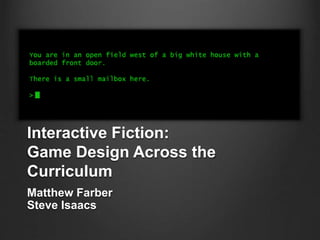Interactive fiction
- 1. Interactive Fiction: Game Design Across the Curriculum Matthew Farber Steve Isaacs
- 4. Games Are INTERCONNECTED SYSTEMS 1. A goal 2. Challenge 3. Rules 4. Components 5. Space (The Magic Circle) 6. Core Mechanics
- 8. A GameĄŊs Core Mechanics Set the System of Play in Motion Examples: Arguing Trading Voting Exploring Jumping Guessing Role-Playing Resource management (time is a resource) Press your luck
- 9. Game Design Grammar Games are designed with action verbs. Similarly, BloomĄŊs Taxonomy of Higher Order Thinking is built around verbs. Good games align core mechanics and learning goals.
- 10. Oregon Trail
- 12. Would you have students make the Globe Theater out of Popsicle sticks to teach about MacBeth?
- 14. A Brief History of Text-Based Gaming
- 15. Choose Your Own Adventure
- 20. Device 6
- 22. Mass Effect
- 23. Choices MUST Appear to Matter
- 25. The Walking Dead
- 31. Mission U.S.
- 36. Syrian Journey: Choose your own escape route http://www.bbc.com/news/world-middle-east-32057601
- 38. A Dark Room
- 39. A Dark Room
- 47. The Novelist
- 49. Parable of the Polygons
- 55. Spent
- 58. 80 Days
- 60. Frankenstein
- 61. Authoring Tools
- 62. Inform 7
- 66. Twine
- 67. InkleWriter
- 72. Fail/Lose State
- 75. Reward Reader When Chivalry Choices are Chosen
- 77. Ą°Create a player experience thatĄŊs fun first. If you remove the fun, [players] will feel like theyĄŊre being preached to and itĄŊs not a game any more, thereĄŊs no agency.Ąą -Mary Flanagan, Tiltfactor
- 78. Questions?













































































![Ą°Create a player experience thatĄŊs
fun first. If you remove the fun,
[players] will feel like theyĄŊre being
preached to and itĄŊs not a game
any more, thereĄŊs no agency.Ąą
-Mary Flanagan, Tiltfactor](https://image.slidesharecdn.com/gie-150811232241-lva1-app6892/85/Interactive-fiction-77-320.jpg)


